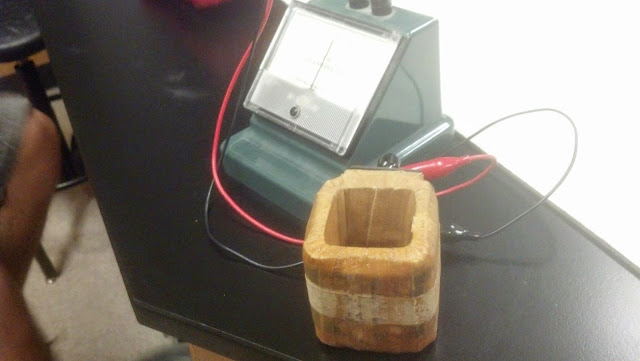 I am not exactly sure what was in this box, but this is the setup for a demonstration Professor Mason performed in class on Monday. The purpose of the demonstration was to show a particular difference between DC voltage and AC voltage. Initially, one half of the box was lit up through a 3 volt DC power source and the other half through a 3 volt AC source. The side lit up by the DC source was much brighter. The sides of the box were not equally as bright until the AC source was turned up to around 4.6 V AC, which is roughly 3 volts RMS.
I am not exactly sure what was in this box, but this is the setup for a demonstration Professor Mason performed in class on Monday. The purpose of the demonstration was to show a particular difference between DC voltage and AC voltage. Initially, one half of the box was lit up through a 3 volt DC power source and the other half through a 3 volt AC source. The side lit up by the DC source was much brighter. The sides of the box were not equally as bright until the AC source was turned up to around 4.6 V AC, which is roughly 3 volts RMS.  In lab, we conducted an experiment in which we calculated a theoretical capacitive reactance and then used current and voltage sensors to construct graphs using LoggerPro that would be used to determine RMS voltages and currents. These voltages and currents would be used to acquire another value of capacitive reactance that we would compare to our theoretical value. We did this for two different capacitors and then found that doubling the frequency greatly reduced our percentage error. We attempted a similar process with an inductor, but found that our results we not nearly as accurate as they were with the capacitor. Also, we simply ran out of time to complete the inductor experiment in its entirety.
In lab, we conducted an experiment in which we calculated a theoretical capacitive reactance and then used current and voltage sensors to construct graphs using LoggerPro that would be used to determine RMS voltages and currents. These voltages and currents would be used to acquire another value of capacitive reactance that we would compare to our theoretical value. We did this for two different capacitors and then found that doubling the frequency greatly reduced our percentage error. We attempted a similar process with an inductor, but found that our results we not nearly as accurate as they were with the capacitor. Also, we simply ran out of time to complete the inductor experiment in its entirety.
This is a sample of the graphs we obtained through use of the voltage and current sensors hooked up into our RC circuit. In order to obtain RMS values for voltage and current, we simply took the maximum value and divided it by the square root of two. We then divided the RMS voltage by the RMS current, which gave us a value of reactance.

















































